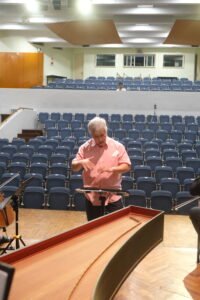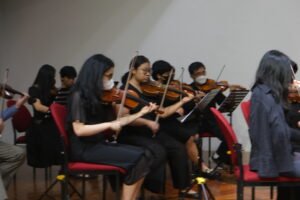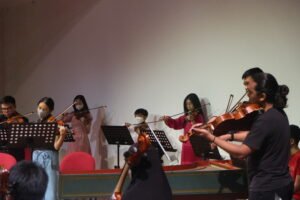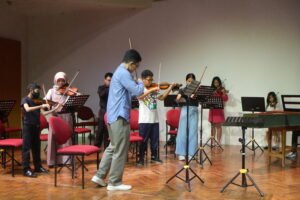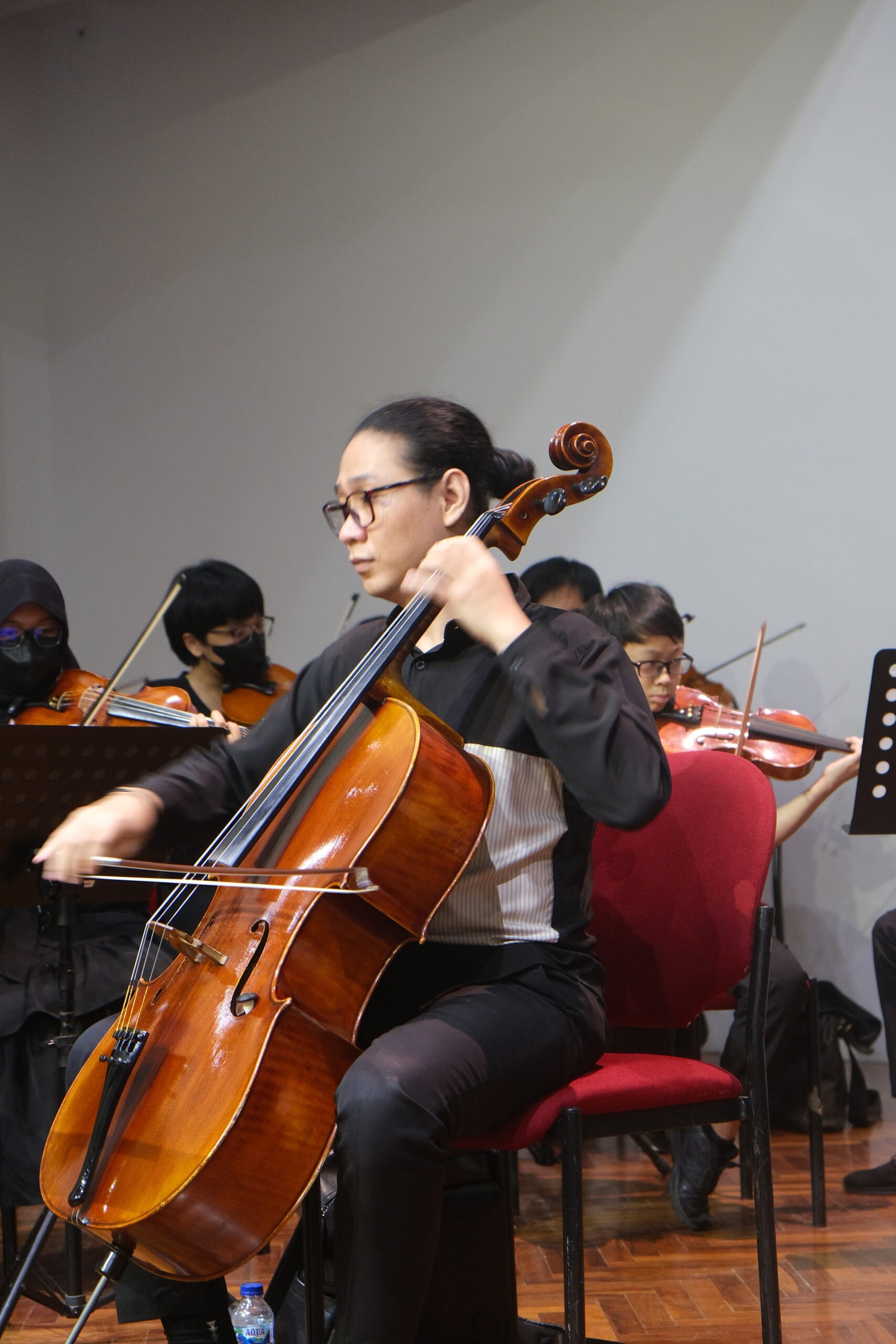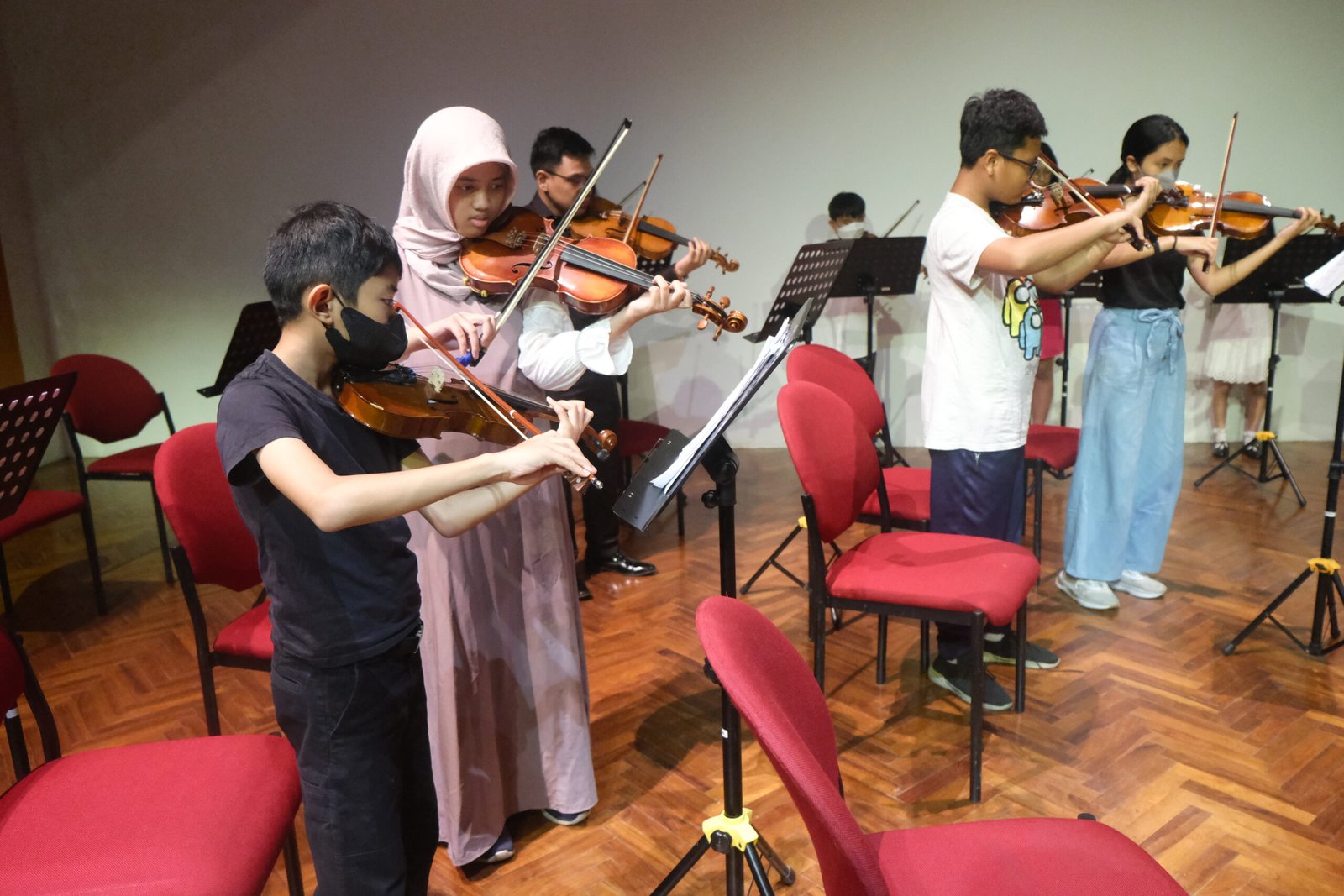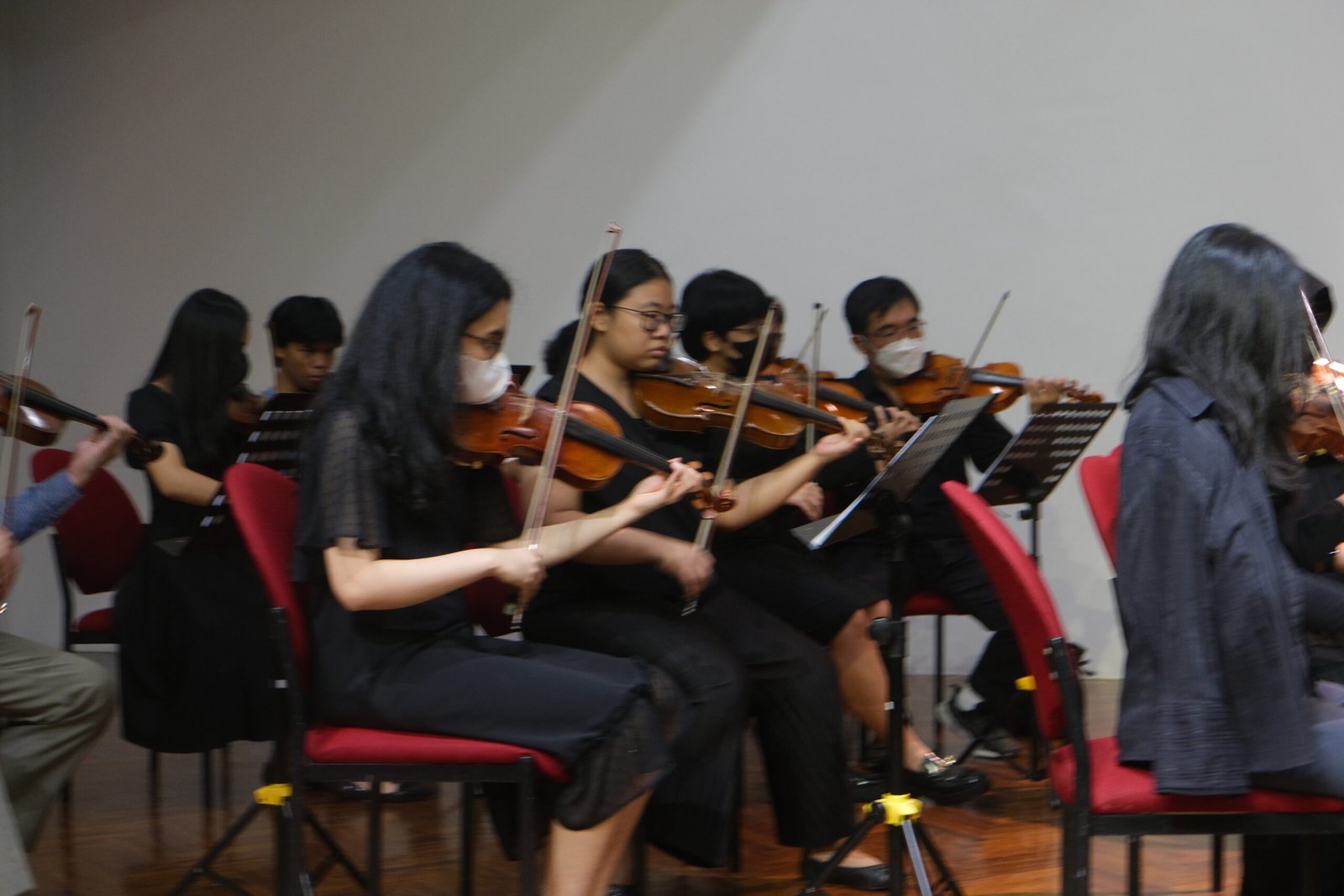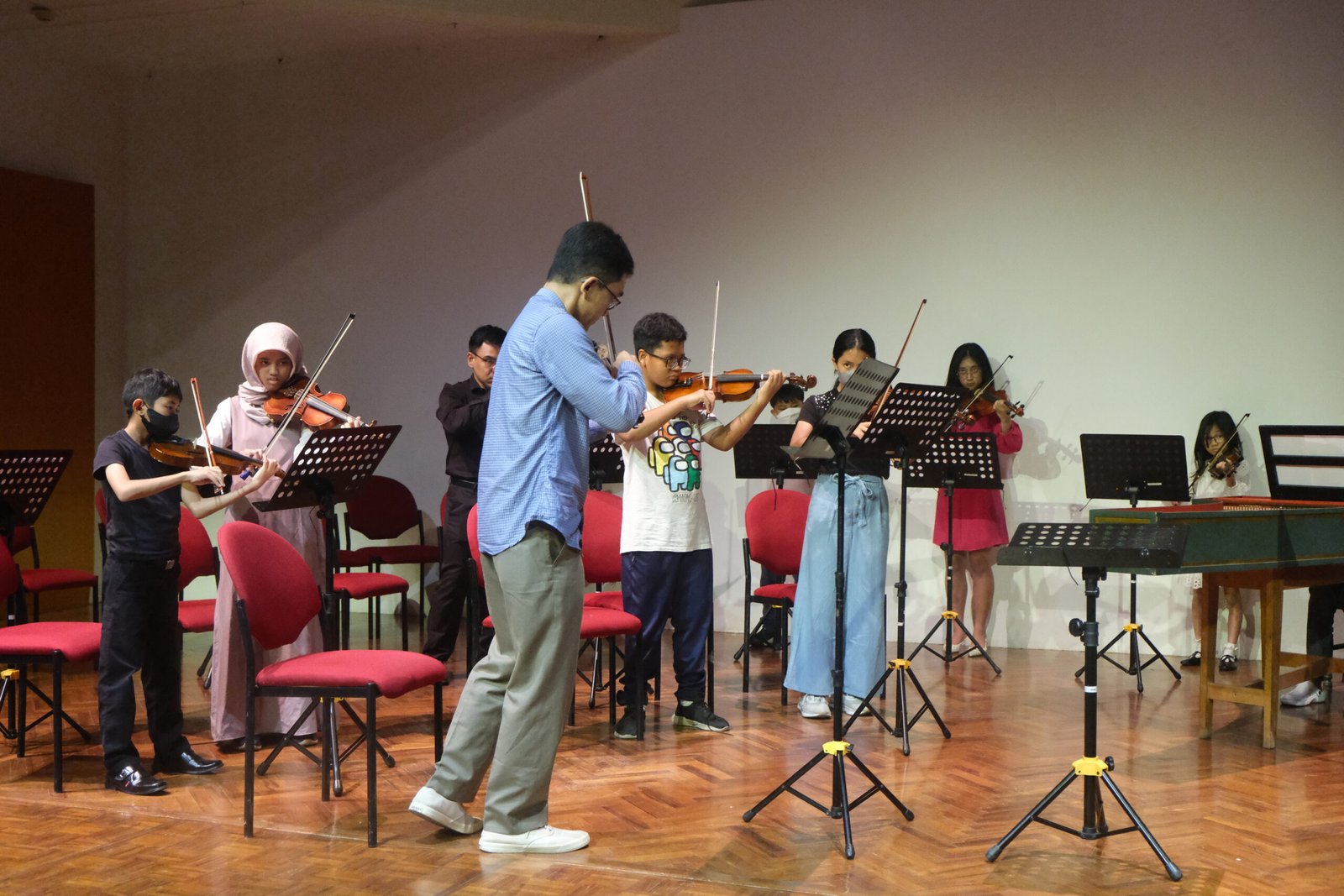A concert with an eclectic program, yet unified by a specific time period and style of music: Krieger in the middle of the Baroque era, Vivaldi at the end of the Baroque era, C.P.E. Bach at the beginning of Rococo, and Gossec at the beginning of Classical – temporally close but physically distant in terms of their musical styles for that time.
Rococo Barocco
19 November 2024 | 17:00
GoetheHaus Auditorium
Program
A. Vivaldi Concerto for Strings in C Major
- Allegro
- [No Tempo]
- Allegro
Concerto for Strings in C Major, RV 115 – Antonio Vivaldi
The ‘Concerto for Strings in C Major, RV 115’ is a superb example of Vivaldi’s compositional style and the hallmark of the Baroque concerto form. The concerto is exclusively scored for strings, featuring violins, violas, cellos, and double basses, without the inclusion of wind instruments. This orchestration creates a chamber music-like setting, allowing Vivaldi to explore the tonal qualities and expressiveness of the strings in depth.
In terms of musical form, the concerto follows the traditional three-movement structure typical of many of Vivaldi’s works. The opening movement, marked Allegro, is characterized by its lively tempo, infectious rhythms, and memorable themes. Vivaldi’s virtuosic writing shines through in this movement, where the strings engage in a spirited dialogue. The second movement, [No Tempo], introduces a contrasting atmosphere with its serene and emotionally charged melodies. The notation [No Tempo] in the second movement of this concerto indicates that the movement is to be performed without a specified tempo marking. In essence, it means that the performers should interpret and play the music freely, without adhering to a strict tempo or beat. This notation is also sometimes indicated by the Italian term “senza tempo” or “ad libitum,” which both signify that the music should be played without a defined tempo. The concerto concludes with the final Allegro, which returns to the energetic character of the first movement, providing a thrilling and triumphant ending.
The theme of the concerto is characterized by its vibrancy, expressiveness, and masterful use of the string ensemble. Vivaldi’s composition is renowned for its dynamic contrasts, with the strings engaging in a spirited dialogue and showcasing the virtuosity of the individual instruments. This concerto encapsulates the essence of the Baroque era, where emotional depth, expressive melodies, and virtuosic displays were celebrated. It stands as a testament to Vivaldi’s exceptional ability to combine technical brilliance with profound emotional expression, making it a cherished gem in the classical music repertoire.
A vital link between the Baroque and Classical eras is served by this concerto, with the spirit of its time embodied and the way for future developments in music being paved. It reflects the composer’s unique style and his contribution to the evolution of the concerto form, offering a glimpse into the rich tapestry of the Baroque period’s musical landscape. This work continues to captivate audiences with its blend of technical excellence and emotional depth, demonstrating Vivaldi’s enduring legacy and his profound influence on the world of classical music.
(Notes by Vicco Vidiana Nyman)
C. P. E. Bach Cello Concerto in A Minor, H. 432
- Allegro assai
- Andante
- Allegro assai
Cello Concerto in A Minor, H. 432 – Carl Philipp Emanuel Bach
In terCarl Philipp Emanuel Bach’s Cello Concerto in A Minor, H. 432 is a notable work that emerged during the transition from the Baroque to the Classical era in the mid-18th century. As the son of the illustrious Johann Sebastian Bach, Carl Philipp Emanuel Bach played a pivotal role in shaping the evolving musical landscape of his time. Composed during his tenure as a court musician in Prussia, this concerto is a testament to his innovative spirit and his role in popularizing the cello as a solo instrument.
In this concerto, the primary instrument featured is, of course, the cello, which serves as the solo instrument. The cello is accompanied by an orchestra of string instruments, including first violin and second violin, violas, and double basses. This composition is typically written for strings only, which means that there are no wind instruments such as flutes, oboes, or horns included in the orchestration. The absence of winds in this concerto highlights the focus on the strings instrument, allowing for a more intimate and chamber music-like setting that complements the expressive and sensitive style characteristic of the mid-18th century.
Structured into three movements, the concerto opens with an Allegro assai, marked by its lively rhythms and captivating themes. This movement showcases virtuosic passages and a dynamic interplay between the soloist and the orchestra. The middle movement, Andante, offers a contrasting emotional depth with its lyrical and introspective melodies, adding a layer of expressive richness to the composition. The concerto concludes with an exhilarating Allegro assai, returning to the spirited character of the first movement, bringing the work to a triumphant closure. This concerto reflects not only his own unique musical style but also the external influences prevalent in the mid-18th century. One significant influence on Bach’s composition was the Empfindsamer Stil, or “sensitive style,” which was a prevailing trend during his time. This style was characterized by a heightened focus on emotional expression and the exploration of dynamic contrasts. Additionally, Bach’s position as a court musician in Prussia, where he composed this concerto, likely exposed him to the evolving tastes and patronage of the Prussian court, which demanded music that was both emotionally evocative and technically challenging.
This concerto exemplifies Carl Philipp Emanuel Bach’s ability to bridge the musical styles of his era, and its enduring appeal lies in its role as a historical and artistic crossroads. It captures the essence of this transformative period, showcasing the development of the cello concerto genre, the evolving compositional techniques, and the emotional depth that characterized his unique approach to music. This concerto remains a cherished masterpiece that resonates with both its historical context and its timeless musical beauty, making it a testament to Carl Philipp Emanuel Bach’s remarkable contribution to the classical music canon.
(Notes by Vicco Vidiana Nyman)ms of musical form, the concerto follows the traditional three-movement structure typical of many of Vivaldi’s works. The opening movement, marked Allegro, is characterized by its lively tempo, infectious rhythms, and memorable themes. Vivaldi’s virtuosic writing shines through in this movement, where the strings engage in a spirited dialogue. The second movement, [No Tempo], introduces a contrasting atmosphere with its serene and emotionally charged melodies. The notation [No Tempo] in the second movement of this concerto indicates that the movement is to be performed without a specified tempo marking. In essence, it means that the performers should interpret and play the music freely, without adhering to a strict tempo or beat. This notation is also sometimes indicated by the Italian term “senza tempo” or “ad libitum,” which both signify that the music should be played without a defined tempo. The concerto concludes with the final Allegro, which returns to the energetic character of the first movement, providing a thrilling and triumphant ending.
The theme of the concerto is characterized by its vibrancy, expressiveness, and masterful use of the string ensemble. Vivaldi’s composition is renowned for its dynamic contrasts, with the strings engaging in a spirited dialogue and showcasing the virtuosity of the individual instruments. This concerto encapsulates the essence of the Baroque era, where emotional depth, expressive melodies, and virtuosic displays were celebrated. It stands as a testament to Vivaldi’s exceptional ability to combine technical brilliance with profound emotional expression, making it a cherished gem in the classical music repertoire.
A vital link between the Baroque and Classical eras is served by this concerto, with the spirit of its time embodied and the way for future developments in music being paved. It reflects the composer’s unique style and his contribution to the evolution of the concerto form, offering a glimpse into the rich tapestry of the Baroque period’s musical landscape. This work continues to captivate audiences with its blend of technical excellence and emotional depth, demonstrating Vivaldi’s enduring legacy and his profound influence on the world of classical music.
(Notes by Vicco Vidiana Nyman)
intermission
J. P. Krieger Lustige Feldmusik No. 2
- Entrée Rondeaux
- Menuet
- Entrée
- Suite
F. J Gossec Symphony in G Major, Op. 12, No. 2
- Allegro molto
- Andante moderato
- Presto moderato
The Jakarta Conservatory Chamber Orchestra is a chamber orchestra consisting of students from the Jakarta Conservatory of Music, Department of Stringed and Wind Instruments, Elementary and Secondary Music Education Program and the Performing Music Diploma Program. As part of the Ensemble Subject training, this orchestra is a place for students to practice their skills playing in a large ensemble or orchestra. Innovative repertoire is always sought after, not only to hone their musical skills, but also to broaden the horizons, appreciation and love of music of the performers, as well as the listeners.
The Jakarta Conseravatorium of Music has previously created several chamber orchestra projects under the name Jakarta Conservatory Junior Orchestra. This project was created to examine the possibility of implementing educational activities for playing in large ensembles or orchestras on a more routine and systematic basis. This activity can be held regularly every semester and is regularly guided and trained by the Jakarta Conservatory of Music teaching staff and directed by Iswargia R. Sudarno as the orchestra’s music director. Until the present, the format of the Jakarta Conservatory Junior Orchestra is still maintained for learning by students at the beginner – early intermediate level.
Jakarta Conservatory Junior Orchestra
Iswargia Renardi Sudarno, born in Bandung, started his conducting activities when he was studying architecture at the Bandung Institute of Technology, as the resident conductor of the Bandung Music Ensemble. During that time, he was also assigned to conduct the debut performance of opera Loro Jonggrang (chamber orchestra version) by Trisutji D. Kamal in Jakarta. While continuing his formal music education for the Master of Music program in Piano Performance at the Manhattan School of Music, New York, under the tutelage of legendary pianist and pedagogue, Karl Ulrich Schnabel, he also extends his orchestral conducting training under David Gilbert (former assistant conductor of New York). York Philharmonic Orchestra and music director of the American Ballet Theater Orchestra) at the Manhattan School of Music, and also under Vincent de La Selva (music director of the New York Grand Opera Company) at The Juilliard School Evening Division. Back in Indonesia, he served as the tutor for the Nusantara Chamber Orchestra and was later appointed music director for the National Youth Orchestra-Indonesia. Currently, apart from leading the Jakarta Sinfonietta, he also serves as music dir ector for the Jakarta Conservatory Chamber Orchestra.
Other activities that absorb a lot of his time is being a pianist and an educator. As a pianist he has performed in five continents and has been the soloist with various orchestras in Indonesia, such as the Jakarta Concert Orchestra, Nusantara Symphony Orchestra, National Youth Orchestra of Indonesia, Symphony Orchestra of the Indonesian Art Institute, as well as with the Jakarta Sinfonietta. His considerable attention to the development of new music in Indonesia gave him the opportunity to work directly with well-known Indonesian composers, such as Trisutji D. Kamal, the late Slamet Abdul Sjukur, Tony Prabowo, Otto Sidhartha, Michael Asmara. He often gives master classes and is a judge for competitions in major Asian cities. Currently, apart from being a senior faculty member at the Jakarta Conservatory of Music, he also serves as the academic director of the institution.
He studied music in Yogyakarta, where he first learned to play cello from Brigida Berta. Then continued studying cello at the Indonesian Institute of Arts under the guidance of Asep Hidayat.
Active as a soloist and chamber musician, Ade has performed at the Yogyakarta Contemporary Music Festival (2007 & 2010), International Chamber Music Yogyakarta (2010-2012), and Jakarta Chamber Music Festival (2009-2011). In 2012 he participated in the Asian Contemporary Music Festival in Izmir, Turkey.
As cellist of d’Java String Quartet, Ade has performed many recitals and given masterclasses in Indonesia and the Philippines (2011). With d’Java String Quartet he won first place in the String Quartet Category at the 3rd Festival and Chamber Competition at Yong Siew Toh Conservatory (Singapore, 2010), and also won the Best Cello Performer award (Singapore, 2010). Collaborated with T’ang Quartet (Singapore) in a Chamber Music Concert in Bandung.
As cellists of Cascade Trio, they have performed in various cities in Indonesia, Thailand and the United States, including participating in the Parahyangan Classical Music Festival 2014 & 2015, receiving invitations for masterclasses and concerts with Trio Arbos (Spain) in Valencia, Spain 2015, Apple Hill Chamber Music Festival in New Hampshire, USA 2016 & 2017.
Ade was selected to represent Indonesia for the South Asian Youth Orchestra and Wind Ensemble in Bangkok, Thailand (2007 & 2008). Domestically, he played for Nusantara Symphony Orchestra with Hikotaro Yazaki (Japan), Jakarta Symphonia Orchestra Asia tour (Taiwan, Hong Kong, Australia), Principal cello Jakarta Sinfonietta with Iswargia Sudarno, Asia Week Orchestra in Tokyo, Japan with Jakarta City Philharmonic with conductor Budi Utomo Prabowo, Principal cello Twilite Orchestra with Addie Ms, with Twilite Orchestra participated in their tour to Slovakia and Germany in 2012.
Ade has attended chamber music masterclasses with Leslie Tan (Singapore), Marcin Swaleszki (Poland), Damien Ventula (France), Sam Haywood (UK), Budhi Ngurah (Indonesia), Sulistyo Utomo (Indonesia), Doric String Quartet (UK), Trio Storioni (Netherlands), and Takashi Shimizu (Japan), Katie Schlaikjer (USA), Trio Arbos (Spain).
Apart from being a performer Ade also teaches at the Jakarta Conservatory of Music (JCom).
Ibram’s musical journey began since he was 5 by watching and following along choir rehearsals coached by her mother. He started taking classical piano lessons at the age of 6 and he stared learning the violin at the age of 9. During his school years, he enthusiastically joined various musical activities such as orchestra, choir, and marching band.
His aunt was his first violin tutor, and since then he learned with Ari Noya and Suharyono. He started to be a student in JCoM when he was in highschool. There he studied under the guidance of Yasmina Zulkarnain, he started to be her teaching assistant at the age of 19. He had participated in international music festivals in Japan and Singapore. He had taken classes with Jun Hong Loh, Itzhak Rashkovsky, Yin Ke, and other distinguished violinists.
He had collaborated with many talented young musician in chamber music performance. As a soloist, he had performed with orchestra led by Iswargia R. Sudarno, Budi Utomo Prabowo, and Asep Hidayat. He had won several prizes at violin competitions in Indonesia, and been a finalist in some international competition. He is currently a teaching staff at JCoM. He also aspires to become an architect. He had a bachelor and professional degree from Universitas Indonesia, where he graduated cum lade.



